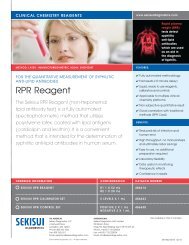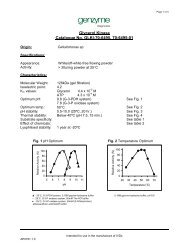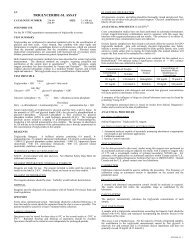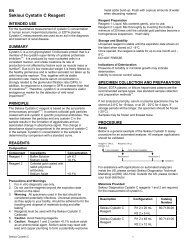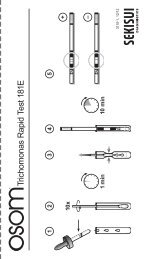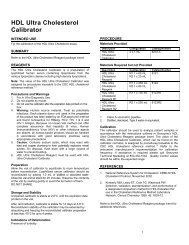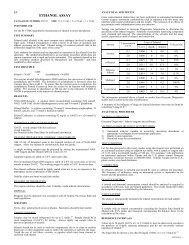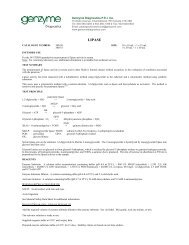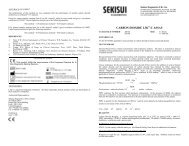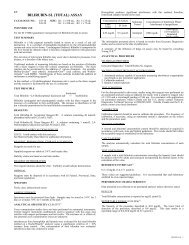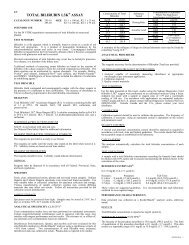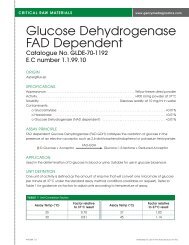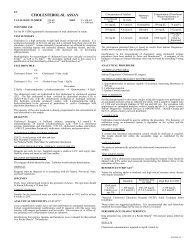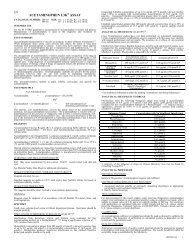Amylase, Direct - Sekisui Diagnostics
Amylase, Direct - Sekisui Diagnostics
Amylase, Direct - Sekisui Diagnostics
Create successful ePaper yourself
Turn your PDF publications into a flip-book with our unique Google optimized e-Paper software.
AMYLASE LIQUID SELECT<br />
CATALOGUE NUMBER: 80-5383-00 SIZE: 10 x 5 mL<br />
80-5451-00 1 x 1 L<br />
INTENDED USE<br />
For the quantitative measurement of -amylase (1, 4-glucan-4-<br />
glucanohydrolase, E.C.3.2.1.1) activity in serum and plasma.<br />
TEST SUMMARY<br />
For many years, the levels of serum and plasma α-amylase in patients<br />
have provided needed evidence for the diagnosis of acute pancreatitis 1-3 .<br />
Early assay techniques were based on either a change in the absorption<br />
maxima of the complex between starch and iodine as the -amylase<br />
degraded the starch; or a measurement of the increase in reducing groups<br />
as the starch was hydrolyzed by the -amylase 4 . These methods are not<br />
as reliable and easy to quantitate as spectrophotometric methods using a<br />
defined substrate 5 .<br />
Some methods are based on the production of NADH proportionate to<br />
the activity of the -amylase. A defined substrate, such as maltotetraose,<br />
is degraded by -amylase to produce glucose which can be measured in<br />
a coupled enzyme assay. However, this method necessitates the removal<br />
of endogenous glucose which would give a high background to the<br />
assay 5 .<br />
More recent methods are based on the production of p-nitrophenol from<br />
defined oligosaccharide substrates with blocking groups attached on the<br />
terminal sugar. The action of the -amylase on the oligosaccharide<br />
yields a variety of chain lengths after hydrolysis. These methods then use<br />
a variety of coupling enzymes to hydrolyze the resulting short chain<br />
oligosaccharides to produce p-nitrophenol 6 . The coupling enzymes<br />
contain residual -amylase activity that may significantly reduce the<br />
stability of the reagent.<br />
TEST PRINCIPLE<br />
The <strong>Amylase</strong> Liquid Select assay involves the use of a chromogenic<br />
substrate, 2-chloro-4-nitrophenol linked with maltotriose 7 .<br />
-amylase<br />
10 CNPG 3 9 CNP + 1 CNPG 2 + G 3 +G<br />
As shown above, -amylase hydrolyzes the 2-chloro-4-nitrophenyl--Dmaltotrioside<br />
(CNPG 3 ) to release 2-chloro-4-nitrophenol (CNP) and<br />
form 2-chloro-4-nitrophenyl--D-maltoside (CNPG 2 ), maltotriose (G 3 ),<br />
and glucose (G). The rate of formation of the 2-chloro-4-nitrophenol can<br />
be detected spectrophotometrically at 405 nm to give a direct<br />
measurement of -amylase activity in the sample. The reaction is not<br />
readily inhibited by endogenous factors.<br />
REAGENTS<br />
Component Ingredients Concentration<br />
<strong>Amylase</strong> Liquid<br />
2.25 mM<br />
Select Reagent<br />
2-Chloro-4-Nitrophenyl<br />
--D-Maltotrioside<br />
(CNPG 3 )<br />
Sodium Chloride<br />
Calcium Acetate<br />
Potassium Thiocyanate<br />
Sodium Azide<br />
Buffer<br />
350 mM<br />
6 mM<br />
900 mM<br />
0.1 %<br />
pH 6.0<br />
WARNINGS AND PRECAUTIONS FOR USE<br />
1. For In Vitro Diagnostic Use.<br />
2. Do not pipette by mouth.<br />
3. Caution: Contains Potassium Thiocyanate. Avoid inhalation or<br />
contact of reagent with skin and eyes. Wash skin or eyes with water<br />
and consult physician if contact occurs. Potassium Thiocyanate is<br />
not compatible with strong acids.<br />
4. Caution: Contains sodium azide, which may react with lead or<br />
copper plumbing to form potentially explosive metal azide. On<br />
disposal, flush drain with a large volume of water to prevent build<br />
up.<br />
5. Avoid contamination of the reagent with salivary -amylase.<br />
See Material Safety Data Sheet for additional information.<br />
REAGENT PREPARATION, STORAGE AND STABILITY<br />
The <strong>Amylase</strong> Liquid Select reagent is supplied ready to use.<br />
Unopened reagent is stable until the expiration date printed on the label<br />
when stored at 2-8°C.<br />
After opening, the reagent is stable for 60 days when properly capped<br />
immediately after each use and stored at 2-8°C.<br />
Reagent is stable for 14 days on board the Roche/Hitachi 911 Analyzer.<br />
REAGENT DETERIORATION<br />
The following results indicate deterioration:<br />
1. Absorbance greater than 0.50 vs. a water blank when measured at<br />
405 nm in a 1 cm cuvette.<br />
2. Inability to recover control values.<br />
3. Presence of turbidity.<br />
DISPOSAL<br />
Reagents must be disposed of in accordance with all Federal, Provincial,<br />
State, and local regulations.<br />
SPECIMEN<br />
Serum, sodium heparinized plasma or lithium heparinized plasma are the<br />
recommended sample types. Other anti-coagulants such as EDTA or<br />
citrate should not be used. Specimens should be collected as per the<br />
National Committee for Clinical Laboratory Standards Guidelines H4-<br />
A3 8 .<br />
Serum: Collect whole blood by venipuncture and allow to clot.<br />
Centrifuge and remove the serum as soon as possible after<br />
collection. 8 (within 3 hours)<br />
Plasma: Specimens may be collected in sodium or lithium heparin.<br />
Centrifuge and remove the plasma as soon as possible after<br />
collection. 8 (within 3 hours)<br />
If not analyzed promptly, samples may be stored ambient (20-25°C) for<br />
14 days, refrigerated (2-8°C) for 21 days or frozen (-20°C) for 10 weeks.<br />
Samples may be frozen (-20°C), in a non-frost (frost free) freezer, and<br />
thawed for up to two freeze/thaw cycles. Refer to NCCLS Document<br />
H18-A for further instructions on specimen collection, handling, and<br />
storage.<br />
(IN80538300-2) 1
ANALYTICAL SPECIFICITY<br />
1. Refer to the work of Young et al 12 for a review of drug effects on<br />
amylase levels.<br />
2. <strong>Amylase</strong> enzyme activity is temperature dependent. 9 Assays<br />
performed at temperatures 37°C will show an apparent<br />
decrease or increase in amylase levels respectively.<br />
3. Macroamylase has been shown to cause hyperamylasemia which<br />
may lead to overdiagnosis of acute pancreatitis when using<br />
oligosaccharide substrates. 10<br />
4. No significant interference was detected in the <strong>Amylase</strong> Liquid<br />
Select assay up to and including the concentrations stated using the<br />
Roche/Hitachi 911 Analyzer.<br />
Substance Tested Concentration with no<br />
significant (±10%) Interference<br />
Liposyn 3000 mg/dL (1%)<br />
Triglyceride<br />
3000 mg/dL<br />
Ascorbic Acid<br />
50 mg/dL<br />
Bilirubin (unconjugated) 50 mg/dL<br />
Bilirubin (conjugated) 50 mg/dL<br />
Hemoglobin<br />
500 mg/dL<br />
Glucose<br />
2000 mg/dL<br />
Samples with hemoglobin interference higher than the upper limit may<br />
be diluted 1 part sample with 1 part physiological saline. Multiply the<br />
result by two to correct for the dilution.<br />
ANALYTICAL PROCEDURE<br />
MATERIALS PROVIDED<br />
The <strong>Amylase</strong> Liquid Select Reagent is packaged in various formats. Any<br />
of the following items may be included in the package you receive.<br />
Description Configuration Catalog Number<br />
<strong>Amylase</strong> Liquid 1 x 1 L 80-5451-00<br />
Select Reagent<br />
<strong>Amylase</strong> Liquid<br />
Select Reagent<br />
10 x 5 mL 80-5383-00<br />
MATERIALS REQUIRED (BUT NOT PROVIDED)<br />
1. Class A volumetric pipettes.<br />
2. Spectrophotometer which maintains cuvette assay temperature at<br />
37°C and is capable of measuring absorbance at 405nm.<br />
3. Normal saline.<br />
4. Cuvette covers or film.<br />
5. Timer or stopwatch.<br />
6. <strong>Amylase</strong> control sera or quality control material (See “Quality<br />
Control”).<br />
MANUAL ASSAY<br />
1. Pipette 1.0 mL of the α-amylase reagent into appropriate number of<br />
cuvettes for duplicate sampling and preparation of a blank.<br />
2. Transfer the cuvettes to the spectrophotometer and equilibrate to<br />
37°C ± 1°C.<br />
3. Pipette 25 µL of patient or control sample to the cuvette, cover and<br />
mix briefly by inversion.<br />
4. Introduce 25 µL of normal saline to the blank cuvette and mix by<br />
inversion.<br />
5. Record absorbance at 405 nm for the blank, each of the samples and<br />
controls after 60 seconds and again after 120 seconds.<br />
6. Subtract the absorbance value at 60 seconds from the 120 second<br />
absorbance value to obtain the ∆A/min for each of the blanks,<br />
controls and samples.<br />
NOTES<br />
1. The millimolar absorptivity of 2-chloro-4-nitrophenol varies with<br />
pH, temperature and wavelength.<br />
2. Ensure that cuvette covers or films are not interchanged between<br />
samples.<br />
AUTOMATED APPLICATION<br />
For assistance with applications on automated analyzers, please contact<br />
<strong>Sekisui</strong> <strong>Diagnostics</strong> Technical Services at 800-565-0265.<br />
CALIBRATION<br />
-<strong>Amylase</strong> activity is calculated based on the millimolar absorptivity of<br />
2-chloro-4-nitrophenol. The millimolar absorptivity of 2-chloro-4-<br />
nitrophenol varies with pH, temperature and wave length. The millimolar<br />
absorptivity at pH 6.0 and 37°C, when measured in a 1 cm cuvette is<br />
12.9. Instrument calibration should be at a wavelength of 405 nm. Refer<br />
to the instrument manual for analyzer specific calibrator procedures and<br />
for guidance in determining calibration frequency.<br />
QUALITY CONTROL<br />
Reliability of test results should be routinely monitored with quality<br />
control materials or serum pools that reasonably represent performance<br />
on patient specimens. Controls or serum pools should be run with each<br />
assay to ensure that the reagents are functioning properly and that correct<br />
procedures have been followed. Quality control materials are intended<br />
for use only as monitors of accuracy and precision. An acceptable range<br />
for each lot of control material should be established by the laboratory. If<br />
control values are not within the expected range confirm procedures<br />
were performed correctly and follow normal troubleshooting measures.<br />
If the problem persists call <strong>Sekisui</strong> <strong>Diagnostics</strong> Technical Services at<br />
800-565-0265. Outside Canada and the U.S., please contact your local<br />
distributor.<br />
Quality control requirements should be established in accordance with<br />
local, state and/or Federal regulations or accreditation requirements.<br />
RESULTS<br />
Calculate the -amylase activity of each sample and control using the<br />
following formula:<br />
-amylase (U/L) =<br />
(∆A/min s - ∆A/min b ) x T.V. x 1000<br />
ε x S.V. x d<br />
Where:<br />
∆A/min s = Change in the absorbance per minute for the sample or<br />
control<br />
∆A/min b = Change in the absorbance per minute for the blank<br />
T.V. = Total volume of the assay (1.025 mL)<br />
1000 = Conversion from U/mL to U/L<br />
ε = Millimolar extinction coefficient of 2-chloro-4-<br />
nitrophenol at 405 nm, pH 6.0 and 37°C (12.9)<br />
S.V. = Sample volume (0.025 mL)<br />
d = Light path (1 cm)<br />
or<br />
(-amylase (U/L) = (∆A/min s - ∆A/min b ) x K)<br />
K = analyzer specific K factor<br />
REFERENCE INTERVALS<br />
The expected range for <strong>Amylase</strong> is 23 – 88 U/L. 11 It is recommended<br />
that each laboratory establish the normal range for its population.<br />
(IN80538300-2) 2
PERFORMANCE CHARACTERISTICS<br />
REPORTABLE RANGE<br />
An absorbance change of 0.0003 OD units per minute corresponds to an<br />
-amylase activity of 1 U/L at 37°C for an extinction coefficient of 12.9.<br />
The <strong>Amylase</strong> Liquid Select Reagent is linear to 2000 U/L on the<br />
Roche/Hitachi 911 Analyzer. If a sample exceeds 2000 U/L, it should be<br />
diluted with an equal volume of normal saline and re-assayed. Multiply<br />
the value from the resulting calculation by 2 to correct for the dilution.<br />
PRECISION STUDIES<br />
Within run precision of the <strong>Amylase</strong> Liquid Select reagent was<br />
determined using four levels of frozen serum pools analyzed 20 times in<br />
a single run on the Roche/Hitachi 911 Analyzer.<br />
Serum Pool 1 2 3 4<br />
n 20 20 20 20<br />
Mean (U/L) 61 272 902 1509<br />
% CV 1.34 0.61 0.51 0.62<br />
Between run precision of the <strong>Amylase</strong> Liquid Select reagent was<br />
determined using four levels of frozen serum pools. Each pool was run in<br />
duplicate for 20 times over at least five days on the Roche/Hitachi 911<br />
Analyzer.<br />
Serum Pool 1 2 3 4<br />
n 40 40 40 40<br />
Mean (U/L) 60 273 917 1507<br />
% CV 1.7 0.8 0.9 0.6<br />
ACCURACY<br />
In comparative performance studies, 50 samples ranging in activity from<br />
28-304 U/L were evaluated by <strong>Amylase</strong> Liquid Select Reagent and<br />
another commercially available -amylase method on the Roche/Hitachi<br />
911 analyzer. The correlation coefficient for the study was r = 0.9985.<br />
The regression equation was y = 0.90 x - 2.50.<br />
The information presented above is based on results from <strong>Sekisui</strong><br />
<strong>Diagnostics</strong>’ studies and is current at the date of publication.<br />
All trademarks, brands, product names and trade names are the property<br />
of their respective companies.<br />
The Americas<br />
<strong>Sekisui</strong> <strong>Diagnostics</strong> P.E.I. Inc.<br />
70 Watts Avenue<br />
Charlottetown, PE C1E 2B9<br />
Canada<br />
Phone: 800-565-0265<br />
Fax: 902-628-6504<br />
Email: questions@sekisuidiagnostics.com<br />
peidiagnostictechnical@sekisuidiagnostics.com<br />
International<br />
<strong>Sekisui</strong> <strong>Diagnostics</strong> (UK) Limited<br />
50 Gibson Drive<br />
Kings Hill, West Malling<br />
KENT, ME19 4AF, UK<br />
Email: info@sekisuidiagnostics.com<br />
www.sekisuidiagnostics.com<br />
<strong>Amylase</strong> Liquid Select<br />
NUMÉRO DE CATALOGUE: 80-5383-00 TAILLE: 10 x 5 mL<br />
80-5451-00 1 x 1 L<br />
UTILISATION PRÉVUE<br />
Pour la mesure quantitative de l'activité de -amylase (1, 4-glucan-4-<br />
glucanohydrolase, E.C.3.2.1.1) dans le sérum et le plasma.<br />
RÉSUMÉ DES TESTS<br />
Depuis plusieurs années, les niveaux de sérum et de plasma<br />
-amylase chez les patients ont fourni une preuve nécessaire pour le<br />
diagnostic de la pancréatite aigue 1-3 . Les premières techniques de dosage<br />
étaient basées soit sur un changement dans le maximum d'absorption du<br />
complexe entre l'amidon et l'iode lorsque le -amylase dégrade l'amidon;<br />
soit sur une mesure de l'augmentation dans les groupes réducteurs<br />
lorsque l'amidon était hydrolysé par le -amylase 4 . Ces méthodes ne sont<br />
pas aussi fiables et faciles à quantifier que les méthodes<br />
spectrophotométriques utilisant un substrat défini 5 .<br />
Certaines méthodes sont basées sur la production de NADH<br />
proportionnel à l'activité de -amylase. Un substrat défini, tel que le<br />
maltotétraose, est dégradé par -amylase pour produire du glucose qui<br />
peut être mesuré par un dosage d'enzyme couplé. Cependant, cette<br />
méthode nécessite l'enlèvement du glucose endogène qui donnerait une<br />
base élevée pour le dosage 5 .<br />
Les méthodes plus récentes sont basées sur le production de p-<br />
nitrophénol à partir de substrats définis d'oligosaccharides avec groupes<br />
bloquants liés au sucre terminal. L'action de -amylase sur<br />
l'oligosaccharide produit une variété de longueurs de chaine après<br />
hydrolyse. Ces méthodes utilisent ensuite une variété d'enzymes<br />
couplantes pour hydrolyser les chaines courtes d'oligosaccharides afin de<br />
produire le p-nitrophénol 6 . Les enzymes couplantes contiennent l'activité<br />
résiduelle de -amylase qui peut réduire de façon significative la stabilité<br />
du réactif.<br />
PRINCIPE DU TEST<br />
Le dosage <strong>Amylase</strong> Liquid Select implique l'utilisation d'un substrat<br />
chromogène, 2-chloro-4-nitrophénol lié avec du maltotriose 7 .<br />
-amylase<br />
10 CNPG 3 9 CNP + 1 CNPG 2 + G 3 +G<br />
Tel que montré ci-dessus, -amylase hydrolyse le 2-chloro-4-<br />
nitrophényl--D-maltotrioside (CNPG 3 ) pour relâcher le 2-chloro-4-<br />
nitrophénol (CNP) et former du 2-chloro-4-nitrophényl--D-maltoside<br />
(CNPG 2 ), du maltotriose (G 3 ) et du glucose (G). Le taux de formation de<br />
2-chloro-4-nitrophénol peut être détecté par spectrophotomètre à 405 nm<br />
pour donner une mesure directe de l'activité de -amylase dans<br />
l'échantillon. La réaction n'est pas facilement inhibée par les facteurs<br />
endogènes.<br />
RÉACTIFS<br />
Composant Ingrédients Concentration<br />
<strong>Amylase</strong> Liquid<br />
2,25 mM<br />
Select Réactif<br />
2-Chloro-4-Nitrophényl<br />
--D-Maltotrioside<br />
(CNPG 3 )<br />
Chlorure de sodium<br />
Acétate de calcium<br />
Thiocyanate de potassium<br />
Azoture de sodium<br />
Tampon<br />
350 mM<br />
6 mM<br />
900 mM<br />
0,1 %<br />
pH 6,0<br />
(IN80538300-2) 3
PRÉCAUTIONS ET MISES EN GARDE RELATIVES À L'EMPLOI<br />
1. Pour usage diagnostic in vitro.<br />
2. Ne pas pipetter par la bouche.<br />
3. Attention: Contient du Thiocyanate de potassium. Éviter l'inhalation<br />
ou le contact du réactif avec la peau et les yeux. Laver la peau ou les<br />
yeux avec de l'eau et consulter un médecin s'il survient un contact. Le<br />
thiocyanate de potassium n'est pas compatible avec les acides forts.<br />
4. Attention: Contient de l'azoture de sodium qui peut réagir avec la<br />
tuyauterie au plomb ou au cuivre et former un azide de métal<br />
potentiellement explosif. Lorsqu'on en dispose, rincer le drain avec<br />
un grand volume d'eau pour prévenir l'accumulation.<br />
5. Éviter la contamination du réactif avec le -amylase salivaire.<br />
Voir la Material Safety Data Sheet pour les informations<br />
supplémentaires.<br />
PRÉPARATION, CONSERVATION ET STABILITÉ DU RÉACTIF<br />
Le réactif <strong>Amylase</strong> Liquid Select est fourni prêt à l'emploi.<br />
Le réactif non-ouvert est stable jusqu'à la date d'expiration imprimée sur<br />
l'étiquette lorsqu'il est entreposé à 2-8°C.<br />
Après ouverture, le réactif est stable durant 60 jours lorsqu'il est<br />
correctement refermé immédiatement après chaque usage et entreposé à<br />
2-8°C.<br />
Le réactif est stable durant 14 jours à l'intérieur de l'Analyseur<br />
Roche/Hitachi 911.<br />
DÉTÉRIORATION DU RÉACTIF<br />
Le suivre indiquerait la deterioration:<br />
1. L'absorbance est plus grande que 0,50 vs. un blanc d'eau lorsque<br />
mesuré à 405 nm dans une cuve cylindrique de 1 cm.<br />
2. Incapacité à recouvrer les valeurs de contrôle.<br />
3. Présence de turbidité<br />
ÉLIMINATION<br />
Les réactifs doivent être éliminés conformément à toutes les<br />
réglementations locale, fédérale, provinciale et de l'État.<br />
SPÉCIMEN<br />
Les échantillons recommandés sont le sérum, le plasma hépariné au<br />
sodium ou le plasma hépariné au lithium. Les autres anti-coagulants tels<br />
que le EDTA ou le citrate ne devraient pas être utilisés. Les spécimens<br />
devraient être recueillis selon les directives H4-A3 du National<br />
Committee for Clinical Laboratory Standards 8 .<br />
Sérum : Recueillir le sang total par ponction veineuse et laisser<br />
coaguler. Centrifuger et enlever le sérum aussitôt que possible<br />
après la collecte. 8 (dans les 3 heures)<br />
Plasma: Les échantillons peuvent être recueillis avec l'héparine au<br />
lithium ou au sodium. Centrifuger et enlever le plasma aussitôt<br />
que possible après la collecte. 8 (dans les 3 heures)<br />
S'ils ne peuvent être analysés rapidement, les échantillons devraient être<br />
entreposés à température ambiante (20-25°C) durant 14 jours, réfrigérés<br />
(2-8°C) durant 21 jours ou congelés (-20°C) durant 10 semaines. Les<br />
échantillons devraient être congelés (-20°C), dans un congélateur non<br />
sans givre et dégelés au plus sur deux cycles de gel/dégel. Se référer au<br />
document NCCLS H18-A pour de plus amples instructions sur la<br />
collecte d'échantillons, leur manipulation et leur stockage.<br />
SPÉCIFICITÉ ANALYTIQUE<br />
1. Se reporter aux travaux publiés par Young et ses collaborateurs, 12<br />
pour une analyse des niveaux d'amylase.<br />
2. L'activité enzymatique de l'amylase est dépendante de la<br />
température. 9 Les dosages effectués à des températures 37°C afficheront respectivement une réduction ou une<br />
augmentation apparente des niveaux d'amylase.<br />
3. Il a été montré que la macroamylase cause l'hyperamylasemia qui<br />
peut amener à un surdiagnostic de pancréatite aigue lorsqu'on utilise<br />
des substrats d'oligosaccharide. 10<br />
4. Aucune interférence significative n'a été détectée dans le dosage<br />
avec <strong>Amylase</strong> Liquid Select jusqu'aux concentrations énumérées en<br />
utilisant l'analyseur Roche/Hitachi 911.<br />
Substance Testée Concentration sans<br />
interférence significative (±10%)<br />
Liposyne 3000 mg/dL (1 %)<br />
Triglycéride<br />
3000 mg/dL<br />
Acide ascorbique 50 mg/dL<br />
Bilirubine (indirecte) 50 mg/dL<br />
Bilirubine (directe) 50 mg/dL<br />
Hémoglobine<br />
500 mg/dL<br />
Glucose<br />
2000 mg/dL<br />
Les échantillons avec interférence d'hémoglobine plus élevée que la<br />
limite supérieure peuvent être dilués 1 partie d'échantillon avec 1 partie<br />
de solution physiologique salée. Multiplier le résultat par deux pour<br />
corriger la dilution.<br />
PROCÉDURE ANALYTIQUE<br />
MATÉRIEL FOURNI<br />
Le réactif <strong>Amylase</strong> Liquid Select est emballé sous différents formats.<br />
Certains des articles ci-dessus peuvent être inclus dans l'emballage que<br />
vous recevez.<br />
Description Configuration Numéro de catalogue<br />
<strong>Amylase</strong> Liquid 1 x 1 L 80-5451-00<br />
Select Réactif<br />
<strong>Amylase</strong> Liquid<br />
Select Réactif<br />
10 x 5 mL 80-5383-00<br />
MATÉRIEL REQUIS (MAIS NON FOURNI)<br />
1. Pipettes volumétriques classe A.<br />
2. Spectrophotomètre qui maintient la température de dosage en cuve<br />
cylindrique à 37°C et peut mesurer l'absorbance à 405 nm.<br />
3. Solution physiologique salée.<br />
4. Couvercles de cuve cylindrique ou film.<br />
5. Minuterie ou chronomètre.<br />
6. Les sérums de contrôle de l'amylase ou du matériel de contrôle de<br />
qualité (Voir « Contrôle de qualité »).<br />
ESSAI MANUEL<br />
1. Pipetter 1,0 mL de réactif α-amylase dans le nombre approprié de<br />
cuves cylindriques pour l'échantillonnage dédoublé et la préparation<br />
d'un blanc.<br />
2. Transférer les cuves cylindriques au spectrophotomètre et équilibrer<br />
à 37°C ± 1°C.<br />
3. Pipetter 25 µL d'échantillon du patient ou de contrôle à la cuve<br />
cylindrique et mélanger brièvement par inversion.<br />
4. Introduire 25 µL de solution physiologique salée à la cuve<br />
cylindrique contenant le blanc et mélanger par inversion.<br />
5. Enregistrer l'absorbance à 405 nm pour le blanc, chacun des<br />
échantillons et contrôles après 60 secondes et de nouveau après 120<br />
secondes.<br />
6. Soustraire la valeur d'absorbance à 60 secondes de la valeur<br />
d'absorbance à 120 secondes pour obtenir le ∆A/min pour chacun<br />
des blancs, contrôles et échantillons.<br />
(IN80538300-2) 4
NOTES<br />
1. L'absorptivité millimolaire de 2-chloro-4-nitrophénol varie avec le<br />
pH, la température et la longueur d'onde.<br />
2. S'assurer que les couvercles de cuve cylindrique ou les films ne sont<br />
pas intervertis entre les échantillons.<br />
APPLICATION AUTOMATISÉ<br />
Pour tout renseignement complémentaire concernant les applications sur<br />
les automates d'analyses, contacter <strong>Sekisui</strong> <strong>Diagnostics</strong> Technical<br />
Services au 800-565-0265.<br />
ÉTALONNAGE<br />
L'activité de -<strong>Amylase</strong> est calculée en se basant sur l'absorptivité<br />
millimolaire de 2-chloro-4-nitrophénol. L'absorptivité millimolaire de 2-<br />
chloro-4-nitrophénol varie avec le pH, la température et la longueur<br />
d'onde. L'absorptivité millimolaire à un pH de 6,0 et 37°C, lorsque<br />
mesuré dans une cuve cylindrique de 1 cm est 12,9. La calibration<br />
d'instrument devrait être à une longueur d'onde de 405 nm. Consulter le<br />
manuel de l'instrument pour les procédures spécifiques du calibrateur de<br />
l'automate d'analyses et les directives de calcul de la fréquence de<br />
calibration.<br />
CONTRÔLE DE LA QUALITÉ<br />
La fiabilité des résultats des tests doit être contrôlée en routine par du<br />
matériel de contrôle de qualité ou des groupes de sérums qui reflètent<br />
raisonnablement les performances obtenues avec des échantillons<br />
cliniques. Les contrôles ou les mélanges de sérum devraient être utilisés<br />
avec chaque dosage pour s'assurer que les réactifs fonctionnent<br />
correctement et que les bonnes procédures ont été suivies. Le matériel de<br />
contrôle de qualité n'est utilisé que pour surveiller l'exactitude et le<br />
précision. Une plage de valeurs acceptables doit être établie pour chaque<br />
lot de matériel de contrôle par le laboratoire. Si les valeurs de contrôle ne<br />
sont pas à l'intérieur de la plage attendue, confirmer que les procédures<br />
ont été effectuées correctement et suivre les mesures de dépannage<br />
normales. Si le problème persiste, contactez <strong>Sekisui</strong> <strong>Diagnostics</strong><br />
Technical Services au 800-565-0265. À l'extérieur du Canada et des<br />
États-Unis, veuillez prendre contact avec votre distributeur local.<br />
Les exigences de contrôle de qualité devraient être établies en accord<br />
avec les règlementations locales, régionales et/ou fédérales ou avec les<br />
exigences d'accréditation.<br />
RÉSULTATS<br />
Calculer l'activité de -amylase de chaque échantillon et contrôler en<br />
utilisant la formule suivante :<br />
(∆A/min s - ∆A/min b ) x T.V. x 1000<br />
-amylase (U/L) =<br />
ε x S.V. x d<br />
Où :<br />
∆A/min s = Changement dans l'absorbance par minute pour<br />
l'échantillon ou le contrôle<br />
∆A/min b = Changement dans l'absorbance par minute pour le blanc<br />
T.V. = Volume total du dosage (1,025 mL)<br />
1000 = Conversion de U/mL à U/L<br />
ε = Coefficient d'extinction millimolaire de 2-chloro-4-<br />
nitrophénol à 405 nm, pH 6,0 et 37°C (12,9)<br />
S.V = Volume d'échantillon (0,025 mL)<br />
d = Trajectoire de la lumière (1 cm)<br />
ou<br />
(-amylase (U/L) = (∆A/min s - ∆A/min b ) x K)<br />
K = facteur K spécifique à l'analyseur<br />
INTERVALLES DE RÉFÉRENCE<br />
La gamme attendue pour l'<strong>Amylase</strong> est 23 – 88 U/L. 11 Il est recommandé<br />
que chaque laboratoire vérifie l'intervalle de référence pour sa<br />
population.<br />
CARACTÉRISTIQUES LIÉES AU COMPORTEMENT<br />
INTERVALLE DE SIGNALEMENT<br />
Un changement d'absorbance de 0,0003 unités OD par minute<br />
correspond à une activité de -amylase de 1 U/L à 37°C pour un<br />
coefficient d'extinction de 12,9.<br />
Le réactif <strong>Amylase</strong> Liquid Select est linéaire à 2000 U/L sur l'analyseur<br />
Roche/Hitachi 911. Si l'échantillon excède 2000 U/L, il devrait être dilué<br />
avec un volume égal de solution physiologique salée et redosé.<br />
Multiplier la valeur du résultat par 2 pour corriger pour la dilution.<br />
ÉTUDES DE PRÉCISION<br />
A l'intérieur de chaque lot, la précision du réactif <strong>Amylase</strong> Liquid Select<br />
a été déterminée en utilisant quatre niveaux de mélanges de sérums<br />
congelés analysés 20 fois dans un seul lot en utilisant l'analyseur<br />
Roche/Hitachi 911.<br />
Mélange de 1 2 3 4<br />
sérum<br />
n 20 20 20 20<br />
Moyenne (U/L) 61 272 902 1509<br />
% CV 1,34 0,61 0,51 0,62<br />
Entre les lots, la précision du réactif <strong>Amylase</strong> Liquid Select a été<br />
déterminée en utilisant quatre niveaux de mélanges de sérums congelés.<br />
Chaque mélange a été testé en double 20 fois durant au moins cinq jours<br />
en utilisant l'analyseur Roche/Hitachi 911.<br />
Mélange de 1 2 3 4<br />
sérum<br />
n 40 40 40 40<br />
Moyenne (U/L) 60 273 917 1507<br />
% CV 1,7 0,8 0,9 0,6<br />
EXACTITUDE<br />
Lors d'études de performance comparative, 50 échantillons dont l'activité<br />
se situait dans la gamme 28-304 U/L ont été évalués par le réactif<br />
<strong>Amylase</strong> Liquid Select et d'autre méthodes -amylase commercialement<br />
disponibles sur l'analyseur Roche/Hitachi 911. Le coefficient de<br />
corrélation pour l'étude était r = 0,9985. L'équation de régression était y<br />
= 0,90 x - 2,50.<br />
Les renseignements susmentionnés sont basés sur les résultats obtenus<br />
dans le cadre des études de <strong>Sekisui</strong> <strong>Diagnostics</strong>. Ils sont à jour à la date<br />
de publication.<br />
Tous les noms commerciaux, les noms de marque de commerce, de<br />
marque et de produit sont la propriété de leurs sociétés respectives.<br />
Les Amériques<br />
<strong>Sekisui</strong> <strong>Diagnostics</strong> P.E.I. Inc.<br />
70, avenue Watts<br />
Charlottetown<br />
(Île-du-Prince-Édouard)<br />
C1E 2B9 Canada<br />
Téléphone: 1-800-565-0265<br />
Télécopieur: 902-628-6504<br />
Courriel: questions@sekisuidiagnostics.com<br />
peidiagnostictechnical@sekisuidiagnostics.com<br />
International<br />
<strong>Sekisui</strong> <strong>Diagnostics</strong> (UK) Limited<br />
50 Gibson Drive<br />
Kings Hill, West Malling<br />
KENT, ME19 4AF, RU<br />
Courriel: info@sekisuidiagnostics.com<br />
www.sekisuidiagnostics.com<br />
(IN80538300-2) 5
Definitions for Symbols/ Définitions des Symboles<br />
Batch Code<br />
Numéro de lot<br />
11. Tietz, NW, “Clinical Guide to Laboratory Tests,” W.B. Saunders<br />
Co., 54 (1983).<br />
12. Young, DS, “Effects of Drugs on Clinical Laboratory Tests”, 4th<br />
Ed., AACC Press, Washington DC; 3-43 to 3-47 (1995).<br />
©2011 <strong>Sekisui</strong> <strong>Diagnostics</strong>, LLC - All rights reserved.<br />
©2011 <strong>Sekisui</strong> <strong>Diagnostics</strong>, LLC - Tous droits réservés.<br />
Manufacturer<br />
Fabricant<br />
IN80538300-2<br />
June 24, 2013<br />
Consult instructions for use<br />
Consulter les directives d’utilisation<br />
In vitro diagnostic medical device<br />
Appareil médical de diagnostic in vitro.<br />
Use by<br />
YYYY-MM-DD or YYYY-MM<br />
Utilisé avant le<br />
AAAA-MM-JJ ou AAAA-MM<br />
Catalog number<br />
Numéro de catalogue<br />
Temperature limitation<br />
Limite de température<br />
Caution, consult accompanying document<br />
Prudence, consulter les documents joints<br />
REFERENCES/RÉFÉRENCES<br />
1. Ranson, JHC, Curr. Prob. Surg., 16:1 (1979).<br />
2. Salt, WB II and Schenker, S., Medicine, 55:269 (1976).<br />
3. Stefanini, P., Ermini, M., and Carboni, M., J. Am. Surg., 110:866<br />
(1965).<br />
4. Henry, RJ, and Chiamori, N., Clin Chem., 6:434 (1960).<br />
5. Kaufman, RA and Tietz, NW, Clin Chem., 26:846 (1980).<br />
6. Blair, HE, U.S. Patent No. 4,649,108.<br />
7. Chavez, RG, et al, U.S. Patent 4,963,479.<br />
8. NCCLS document “Procedures for the Collection of Diagnostic<br />
Blood Specimens by Skin Puncture”, 3rd Ed., 11:11 (1991).<br />
9. Suelter, CH, “A Practical Guide to Enzymology”, Wiley & Sons<br />
(1985).<br />
10. Rosenblum, JL, et al, Clin Chem., 38:9 (1992).<br />
(IN80538300-2) 6



